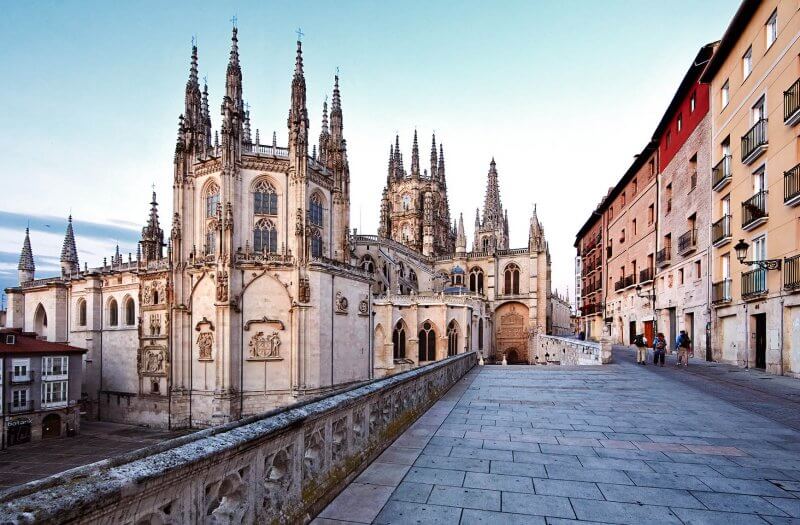The pretty city of Burgos (Spain), belonging to the province of the same name, is located 245 km north of Madrid. Burgos is the 37th largest city in Spain, with an area of 107.08 km2 and a population of about 180,000.
Burgos is located on an 800-meter hill, at the foot of which stretches the picturesque Castilian plains. The Arlanson River flows through the city, which divides it into 2 parts.
Modern Burgos offers its guests everything that is required for a sense of fullness of life: shopping outlets for every taste and prosperity, delicious food and wine, a vibrant and fun nightlife, green boulevards, a beautiful beach on the Arlanson River, the atmosphere of a medieval Old Town.
Attractions in the northern part of Burgos
In the part of Burgos that is located on the right bank of the Arlanson River, there is the Old Town with its many attractions.Old Town Neighborhoods
The historic center of Burgos boasts some of the city’s most beautiful squares:
- Plaza del Mio Sid with monument to Knight Sid Compeador;
- Plaza del Rev San Fernando;
- Plaza Mayor is a square-shaped square typical of Spain, surrounded by houses with arcades;
- Plaza Libertad, famous for the historic Casa del Cordon mansion;
- Plaza Lesmes and the old Bernardos Monastery;
- Plaza Santa Maria, built in the XV century on the site of an ancient cemetery.
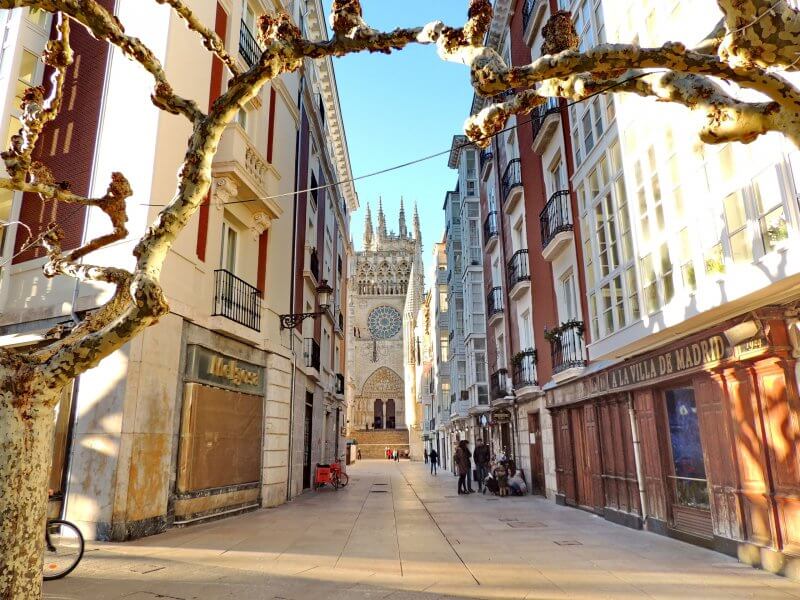
There is also an old boulevard-Paseo del Espolon promenade in the historical part of Burgos, where locals like to relax. Espolon Boulevard stretches along the river for only some 300 meters, but here you can see beautiful buildings from different eras, statues and fountains, a musical gazebo, figuratively trimmed trees and many flower beds.
And the most convenient way to get acquainted with all the sights of the Old Town is from the Santa Maria Bridge, which spans the Arlanson River.
Santa Maria Gate
At the exit from the Santa Maria Bridge there is a gate of the same name. In the XIV century, they were built into the ancient fortress wall, from which now nothing has become.
The gate is a large-scale stone tower with an arched passage. Their lavish facade is decorated with sculptures depicting famous people of Burgos and Spain, as well as statues of the Virgin Mary and the guardian angel of the city.
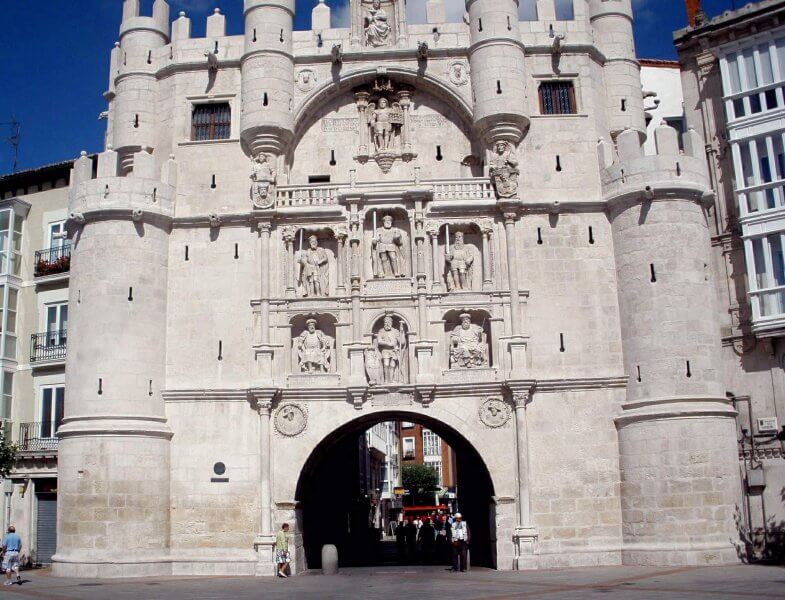
Exhibition halls are now arranged in the inner rooms of the gate towers. Most interesting are the Mudejar-style Main Hall and the octagonal Equality Hall. In one of the rooms there is a Pharmacy Museum, the main exposition of which is old apothecary’s supplies.
Burgos Cathedral
On the other side of the Santa Maria Gate is the Plaza Santa Maria. Facing the main facade of this square and the famous gate, stands the iconic landmark of Burgos and all of Spain – the Cathedral of Our Lady of Burgos.
The cathedral is recognized as a masterpiece of Spanish Gothic architecture. The building has the shape of a Latin cross, its length reaches 84 m, and width – 59 m.
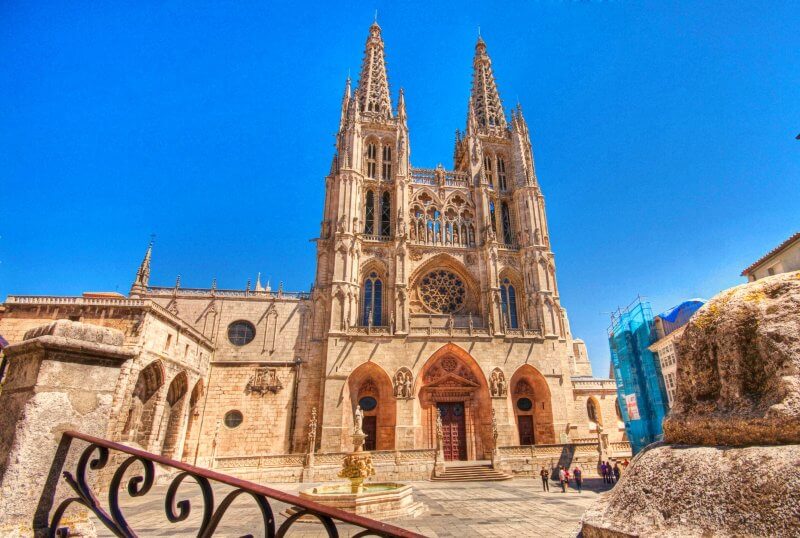
Interesting fact! Burgos Cathedral is the third largest cathedral in Spain after Seville and Toledo.
The main facade of the cathedral is dedicated to the Virgin Mary. It is more convenient to view it from top to bottom. In the central part of the arcade, between the towers, there is a statue of the Virgin. Below are sculptural images of the 8th kings of Castile, below them is a huge rose window with a hexagonal star of David in the center. There are 3 pointed arches in the lower tier. The central arch is the main entrance to the building, which opens only to members of the royal family, while the more modest side doors serve as an entrance for ordinary believers.
The northern facade of the cathedral is dedicated to the apostles. In the center, above the entrance doors, there are scenes of the Last Judgment.
On the east side of the main building are low vipers made in the Renaissance style and decorated with heraldic symbols of the noble families of Velasco and Mendoza. Also here you can see scenes from the life of John the Baptist. Above the eastern doors, at a height of 15 m, there is a completely unconventional decoration for any cathedral: a clock with a moving figure of Papamos (Simpleton).
The most ancient (1230), as well as the most beautiful and interesting facade of the cathedral-south, facing the Plaza del Rev San Fernando (San Fernando Square). The Gothic statues that adorn the facade represent the “Divine Liturgy”. Here, on the south side of the cathedral, there are ticket offices: to see the main religious attraction of Burgos inside, you need to buy a ticket and then climb the stairs to the south portal.
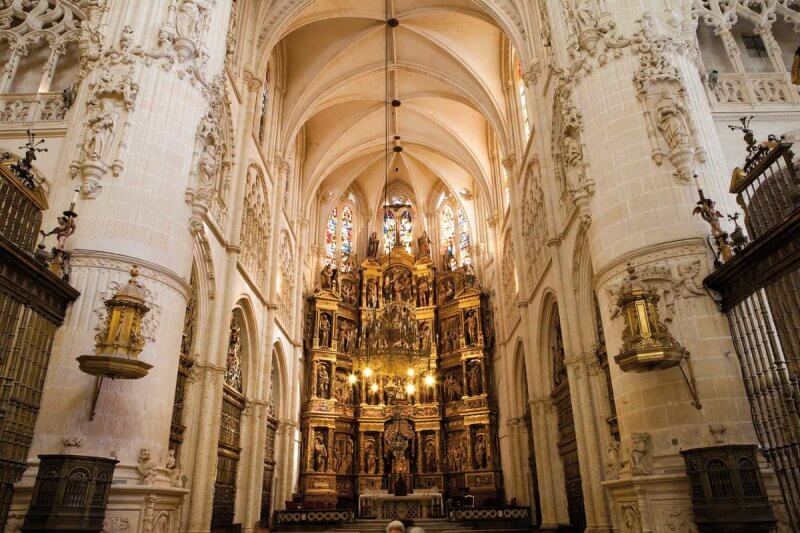
Interesting fact! In 2012, Spain issued a commemorative coin with a face value of 2€, which depicts the Burgos Cathedral. The coin’s circulation was 8,000,000 copies.
Inside, the Cathedral of the Virgin is divided into 3 spacious naves. The building has a lot of light and air, everything looks easy and elegant. The interior of the cathedral is rich and grandiose: a lot of gilding, luxurious stone carvings, statues and altars. The main altar is decorated with a Gothic image of Santa Maria la Mayor. At the northern entrance, the magnificent Renaissance Golden staircase of Diego de Siloe, made of white and cream marble with gilded iron railings, has been preserved. The choir railings are decorated with carvings on the theme of biblical scenes, and in front of the choir is the burial place of Cid Campeador and his wife Jimena.
Sid Campeador is a famous Spanish national hero, born in Burgos.
Practical information for visitors to the Burgos Cathedral
Address: Plaza Santa Maria s / n, 09003 Burgos, Spain.
The Cathedral in Burgas operates on the following schedule::
- from March 19 to October 31: from 09: 30 to 19: 30;
- from November 1 to March 18: from 10: 00 to 19: 00;
- the last entry is possible 1 hour before closing time;
- Tuesdays are always closed from 16: 00 to 16: 30.
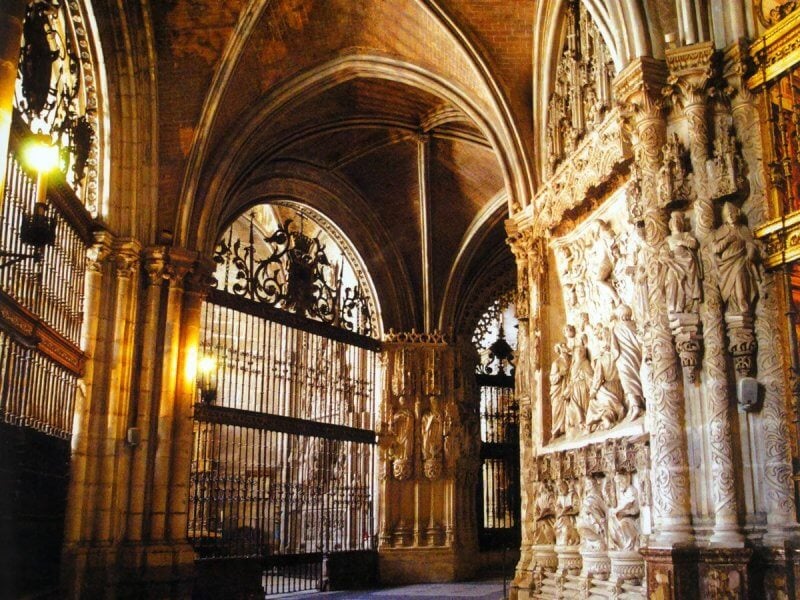
The cathedral may also be closed to tourists on public holidays, information is always available on the website. http://catedraldeburgos.es
Children under the age of 7 are admitted to the cathedral free of charge. On Tuesdays from 16: 30 to 18: 30 in summer and until 18: 00 in winter, absolutely free admission for everyone. At other times, the entrance is for tourists by ticket:
- for adults – 7 €;
- for pensioners over 65 years of age – 6 €;
- for the unemployed, students under 28 – €4.50;
- for children aged 7-14 and disabled – 2 €.
An audio guide in Spanish or English is issued along with the ticket.
Interesting fact! Along the Arlanson River, the St. James’s Way has long been running – this is the name of the road to Santiago de Compostela, where St. James is buried. Pilgrims going there make a mandatory stop in Burgos to visit the Cathedral.
St. Nicholas Church
The church of San Nicolas de Bari is located behind the Cathedral of Burgos – you need to go up to it by a wide staircase, which is laid to the left of the cathedral (if you stand facing it).
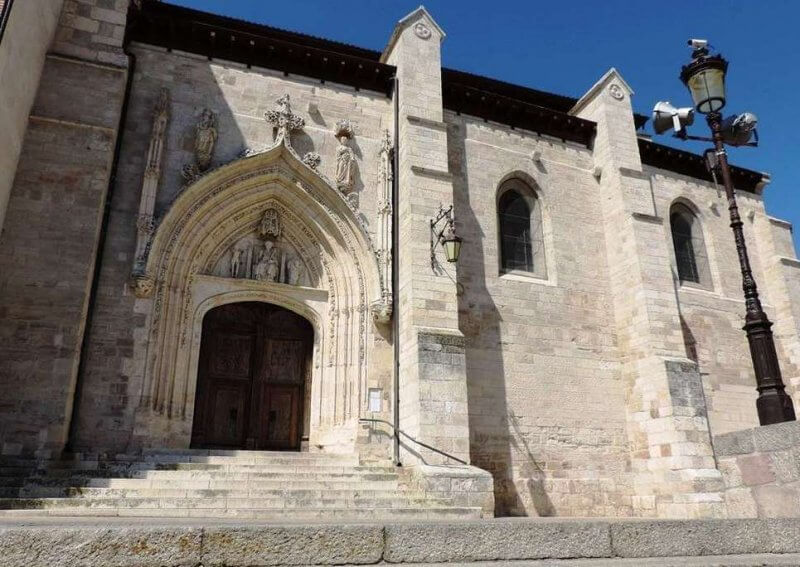
Small, outwardly very modest stone church of St. Nicholas impresses with its internal proportionality and harmony. Its main value and attraction is the majestic stone altar in the form of a book telling about the life of St. Nicholas. The altar is so artfully and elaborately carved that it seems incredibly light and elegant.
A tip! If you drop a 1 €coin into a special opening in the altar, a very beautiful light will turn on.
Address of the Church of St. Nicholas: Calle de Fernan Gonzales, 09003 Burgos, Spain.
Burgos Castle
Castillo de Burgos, or rather the ruins that remain of it, is located on the top of the San Miguel hill. It is better to go up to this attraction on foot, the ascent passes through a very picturesque area and takes 25-30 minutes. You can start your journey from the cathedral, up the same staircase: first along Calle Fernan Gonzales, then along the steps in the park to the observation deck, and then along the path to the top of the hill.

The castle, built in 884, has long been one of the most reliable defensive fortifications. Then it was used both as a royal residence and as a prison, and during the civil war in the 1930s it was destroyed.
The attraction that is now available for inspection is more striking with its spirit of medieval Spain and well-groomed. The watchtower, 75 m above the city, offers the best views of Burgos and the Cathedral.
There is a small museum on the territory of the Castillo Castle, where behind the ropes there are untouched ruins of ancient walls, copies of objects found here. The organization is amazing: no employees, only an announcer in Spanish talks about the past of this place.
The most impressive part of the ancient Burgos Castle is the underground tunnels and the 61.5 m deep well. You can see these sights during the tour – they are held every day, starting at 10:00, 11:00, 12:00, 13:00, 14:00, 15:30, 16:15.
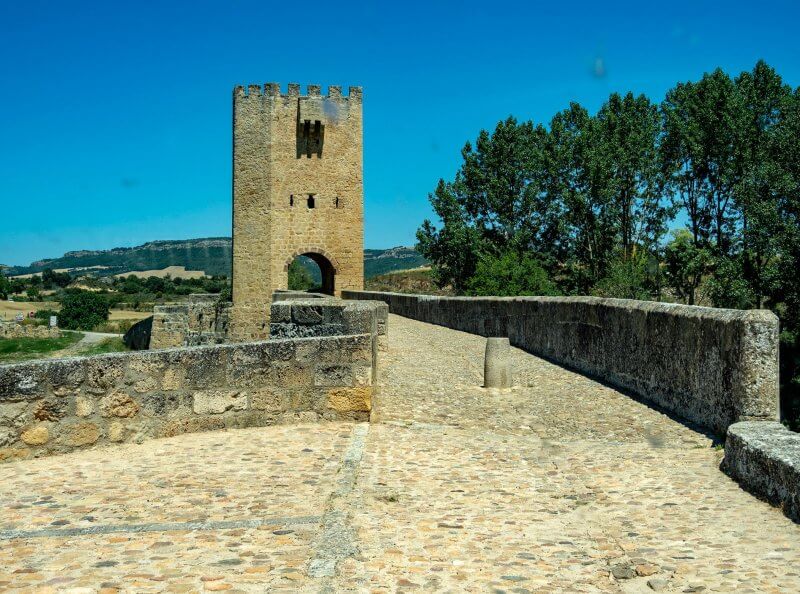
Castillo de Burgos is open to the public daily from 9: 45 to 16: 30.
Entrance to the territory, visit to the museum, excursion to the dungeon-all free of charge.
Address of the attraction: Cerro de San Miguel, s / n, 09004 Burgos, Spain.
Attractions on the left bank of Burgos: Las Huegas Monastery
Mostly new districts are located on the left coast. Although there are also some sights of Burgos that are known in Spain and beyond. For example, the Cistercian Convent of Santa Maria la Real de Huelgas for women. It is famous for crowning, ordaining, knighting, marrying, and burying the kings of Castile and Leon. The monastery, founded in the XII century, is still active, but it is open to the public.
A special attraction: a church with a luxurious gilded altar and a pantheon with the graves of Castilian kings. In the Capilla de Santia chapel there is a wooden statue of Saint James with a sword, which was used in the rites of initiation into the knights of the Order of Santiago. The St. Ferdinand Gallery is now occupied by the Fabric Museum, which displays the robes of kings, as well as a collection of paintings, tapestries, and historical relics.
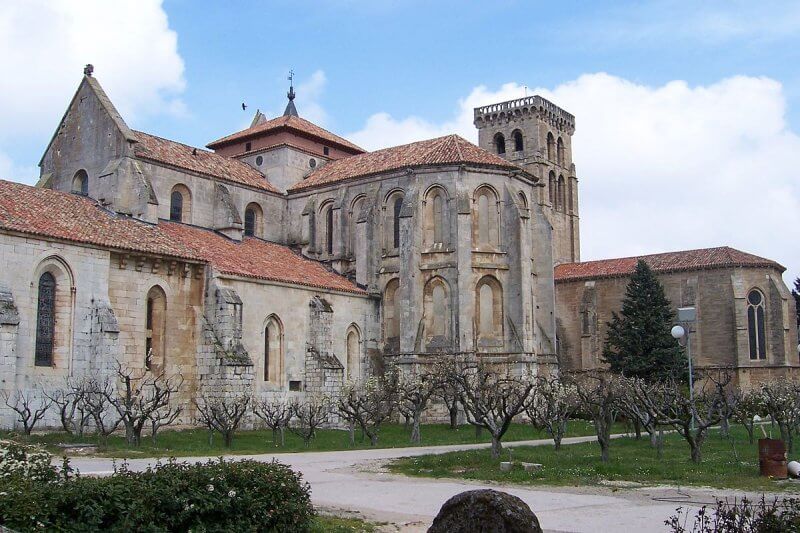
The entrance to the territory of Las Huegas is free – you can go in and inspect all the structures from the outside, take a walk around the cozy courtyard. But you can only go inside as part of an organized paid excursion.
Important! Guided tours are available in Spanish only. You can’t take photos. A security guard follows the group and monitors it.
Place of interest address: Plaza Compás, s / n, 09001 Burgos, Spain.
Access to the territory is possible:
- Sunday-from 10: 30 to 14: 00;
- Tuesday-Saturday – from 10:30 to 17: 30, break from 13: 00 to 16: 00.
Points of interest in the surrounding area: Miraflores Carthusian Monastery
The monastery dedicated to the Holy Virgin of Miraflores is located on a hill in the Fuentes Blancas Park-this is outside the city, 4 kilometers east of the center of Burgos. Since public transport does not go there, you must either take a taxi or walk. Although the road passes through a nice area along the Arlanson River, but on foot, especially in the heat, it is long and tiring to walk.
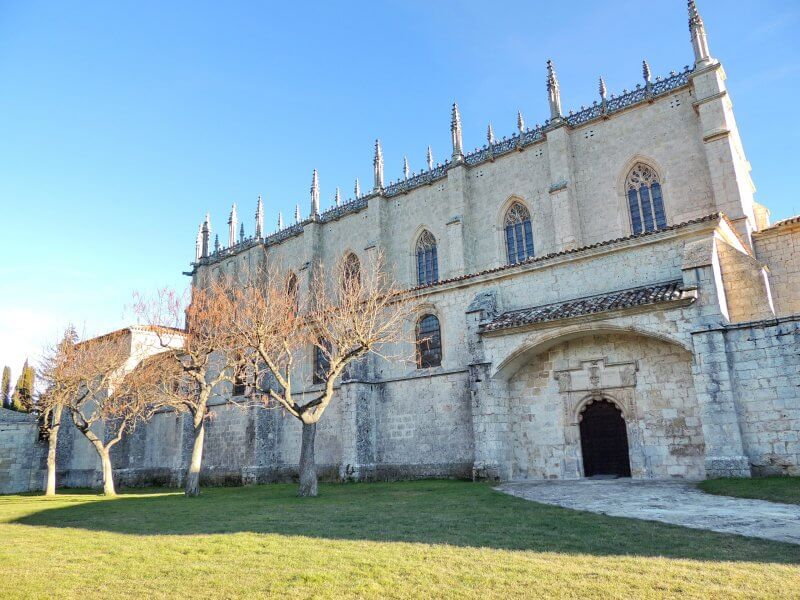
Cartuja de Miraflores is a monastery complex of the XV century with many buildings. It was originally a hunting royal palace, but Juan II gave it to the monastic order of the Carthusians. Since the monastery is active, tourists are only allowed to enter the church.
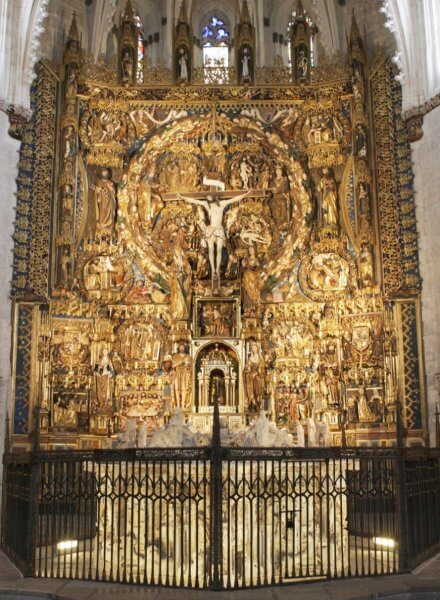
The church is a fine example of late Gothic architecture. Inside, everything is incredibly luxurious, many of the interior items are historical landmarks:
- painting “Annunciation” at the entrance;
- altar made by sculptor Gil de Siloe; the first gold brought by Christopher Columbus from America was used to gild this altar;
- famous statue of Saint Bruno, who founded the Carthusian Order;
- in the center of the nave is the tomb of Juan II and his wife Isabella of Portugal.
Entrance to the monastery complex is free, visiting time:
- Monday-Saturday – from 10: 15 to 15: 00 and from 16: 00 to 18: 00;
- Sunday – from 11: 00 to 15: 00 and from 16: 00 to 18: 00.
Address of the attraction: Pje. Fuentes Blancas s / n, 09002 Burgos, Spain.
Hotels in Burgos
Website booking.com It offers more than 80 hotels of all categories in Burgos and its immediate surroundings: from comfortable hostels to 5* hotels. 3* hotels are attractive, as many of them are located in beautiful historical buildings near famous attractions. A good option is comfortable apartments in the city, as well as family-run guest houses in the countryside, just 5-10 minutes ‘ drive from Burgos.
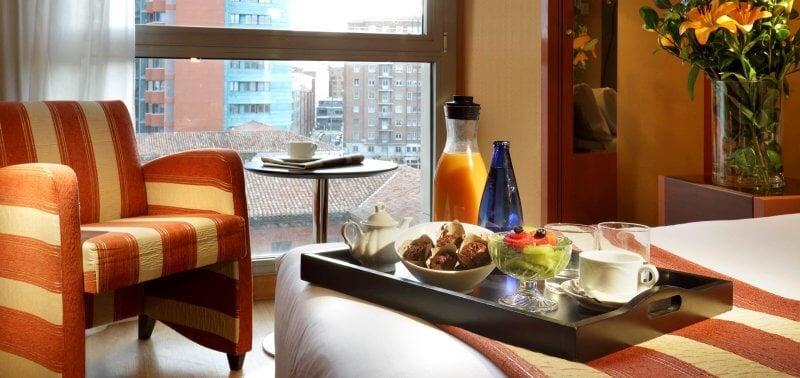
Estimated price per night of stay:
- in the hostel-from 30 € per person;
- in a double room in a 3* hotel – 45-55 €;
- in apartments – 50-100 €.
How to get to Burgos
The advantageous location of Burgos has made it an important communication center in northern Spain. Getting to this city is not difficult, as “all the roads of Castile lead to Burgos”.
The most popular and convenient options are train and bus. You can find suitable flights and buy tickets for any type of transport between Burgos and other cities in Spain on the website.
Travel by rail
Burgos-Rosa de Lima Train Station is located at a distance of 5 km from the city center, in the Villímar district, on Avenida Príncipe de Asturias s / n.
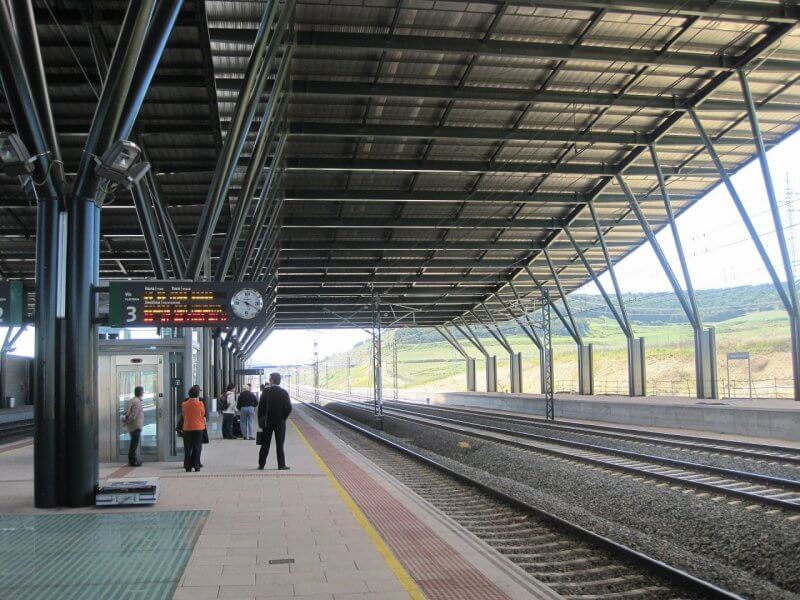
Since 2007, there is a regular train service between Burgos and the main Spanish cities. High-speed trains constantly arrive here from:
- Bilbao (travel time 3 hours, ticket costs €18);
- Salamanca (2.5 hours on the road, price – 20 €);
- Leona (2 hours drive and costs €18);
- Valladolidola (just over 1 hour, ticket 8 €);
- Madrid (4 hours drive, price 23€).
Direct connections are also available to Barcelona, Vigo, Endaya, San Sebastian, and Vitoria. Burgos is served by trains to Paris and Lisbon.
Bus ride
Traveling to Burgos by bus usually takes less time and costs less than by train.
The Burgos Bus Station is located next to the Cathedral, on Calle Miranda nº4-6.
Bus routes connect Burgos with the nearest cities in France and Portugal, with most cities in northern Spain and Madrid. For example, there are several daily flights in the direction of Madrid – Burgos, the trip lasts 2 hours and 45 minutes, and the ticket costs 15 €. Other popular destinations include Valladolid, Leon, Bilbao, San Sebastian, Pamplona.
Conclusion
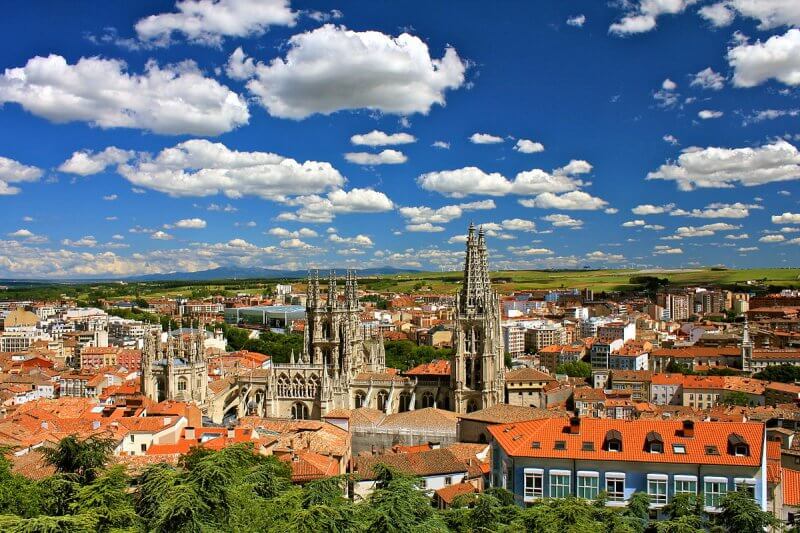
Burgos (Spain) – a small city, to see all its sights and walk along the ancient streets is enough for a few days.
Vigo, Spain: A Promising New Destination for Travelers

